Aquaponics systems represent an innovative approach to sustainable food production by merging aquaculture and hydroponics. This symbiotic relationship allows fish waste to nourish plants while the plants naturally filter and purify the water for the fish, resulting in efficient waste reduction and sustainable protein production. By creating a self-sustaining ecosystem, aquaponics enhances biodiversity and minimizes resource use, making it a promising solution for modern agriculture.
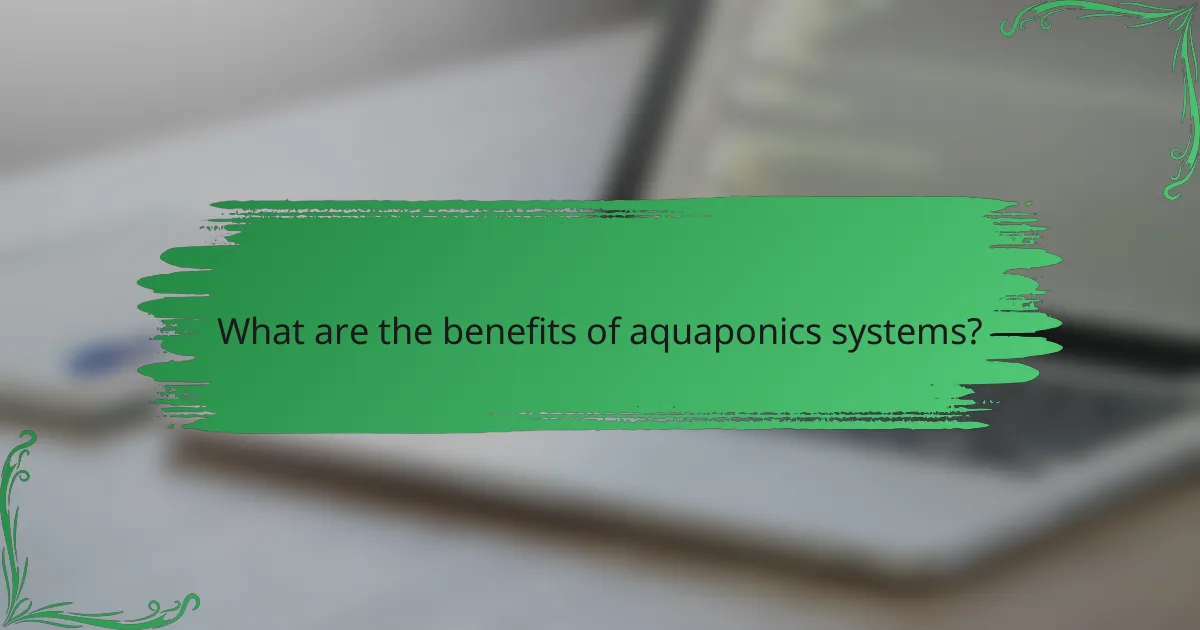
What are the benefits of aquaponics systems?
Aquaponics systems offer numerous benefits, including efficient waste reduction, sustainable protein production, and enhanced biodiversity. By integrating aquaculture and hydroponics, these systems create a self-sustaining environment that minimizes resource use and maximizes output.
Waste reduction through nutrient recycling
Aquaponics systems excel in waste reduction by recycling nutrients. Fish waste provides essential nutrients for plants, which in turn filter and purify the water for the fish. This closed-loop system significantly reduces the need for external fertilizers and minimizes environmental pollution.
By utilizing this natural nutrient cycle, aquaponics can reduce waste by up to 90% compared to traditional farming methods. This not only benefits the environment but also lowers operational costs for producers.
Efficient use of water resources
Aquaponics systems use significantly less water than conventional agriculture, often requiring only about 10% of the water needed for soil-based farming. The water is recirculated within the system, which minimizes evaporation and runoff.
This efficiency is crucial in areas facing water scarcity. For instance, a small aquaponics setup can produce a substantial yield while conserving precious water resources, making it an attractive option for arid regions.
Production of sustainable protein sources
Aquaponics systems can produce fish and plant proteins in a sustainable manner. Fish such as tilapia or catfish can be raised alongside vegetables like lettuce or herbs, providing a diverse food source. This dual production enhances food security and reduces reliance on unsustainable protein sources.
Moreover, the ability to grow fish and plants together allows for a more resilient food system, capable of adapting to changing environmental conditions and market demands.
Reduced need for chemical fertilizers
One of the key advantages of aquaponics is the reduced reliance on chemical fertilizers. The nutrient-rich water from fish tanks nourishes the plants, eliminating the need for synthetic fertilizers that can harm the environment.
This organic approach not only promotes healthier crops but also aligns with growing consumer demand for chemical-free produce. As a result, aquaponics can appeal to environmentally conscious consumers and markets.
Enhanced biodiversity in food production
Aquaponics systems promote biodiversity by allowing for the cultivation of various plant species alongside fish. This diversity can lead to healthier ecosystems, as different plants can attract beneficial insects and improve soil health.
Additionally, incorporating a variety of crops can help mitigate risks associated with pest outbreaks or market fluctuations. By diversifying production, aquaponics systems can contribute to a more stable and resilient food supply chain.
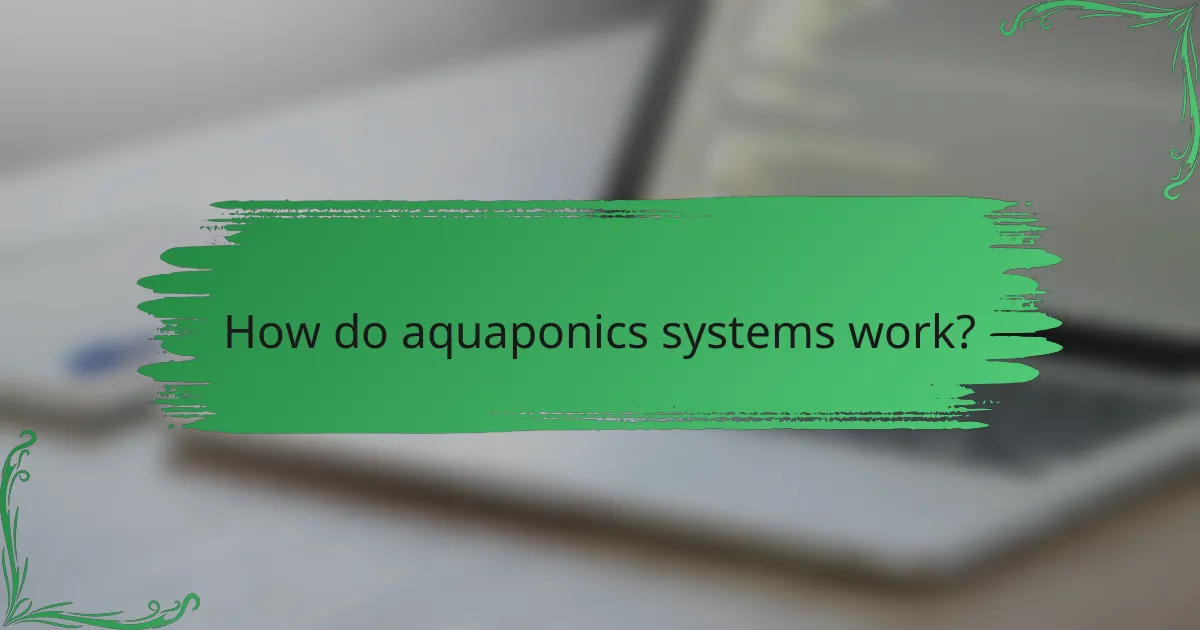
How do aquaponics systems work?
Aquaponics systems combine aquaculture (raising fish) and hydroponics (growing plants in water) to create a sustainable food production method. In this symbiotic relationship, fish waste provides essential nutrients for plants, while plants help filter and purify the water for the fish.
Symbiotic relationships between fish and plants
The core of aquaponics lies in the symbiotic relationships between fish and plants. Fish produce waste that contains ammonia, which is toxic to them but serves as a nutrient source for plants. As plants absorb these nutrients, they clean the water, creating a healthier environment for the fish.
Common fish species used in aquaponics include tilapia, catfish, and trout, while plants can range from leafy greens to herbs and even fruiting plants. This diversity allows for a variety of food production in a compact space.
Biological filtration processes
Biological filtration in aquaponics relies on beneficial bacteria to convert fish waste into usable nutrients for plants. This process typically involves two stages: first, ammonia is converted to nitrites, and then nitrites are transformed into nitrates, which are less harmful and easily absorbed by plants.
Maintaining a balanced ecosystem is crucial. Regular monitoring of water quality, including pH and ammonia levels, helps ensure that both fish and plants thrive. A well-functioning biological filter can significantly reduce the need for chemical fertilizers.
Closed-loop ecosystem dynamics
Aquaponics systems operate as closed-loop ecosystems, where waste from one component becomes a resource for another. This minimizes waste and maximizes efficiency, making aquaponics a sustainable method for food production.
To optimize these dynamics, it’s essential to regularly check the health of both fish and plants. Adjusting feeding schedules, plant types, and water conditions can enhance productivity and ensure a balanced ecosystem. Avoid overfeeding fish to prevent excess waste and water quality issues.
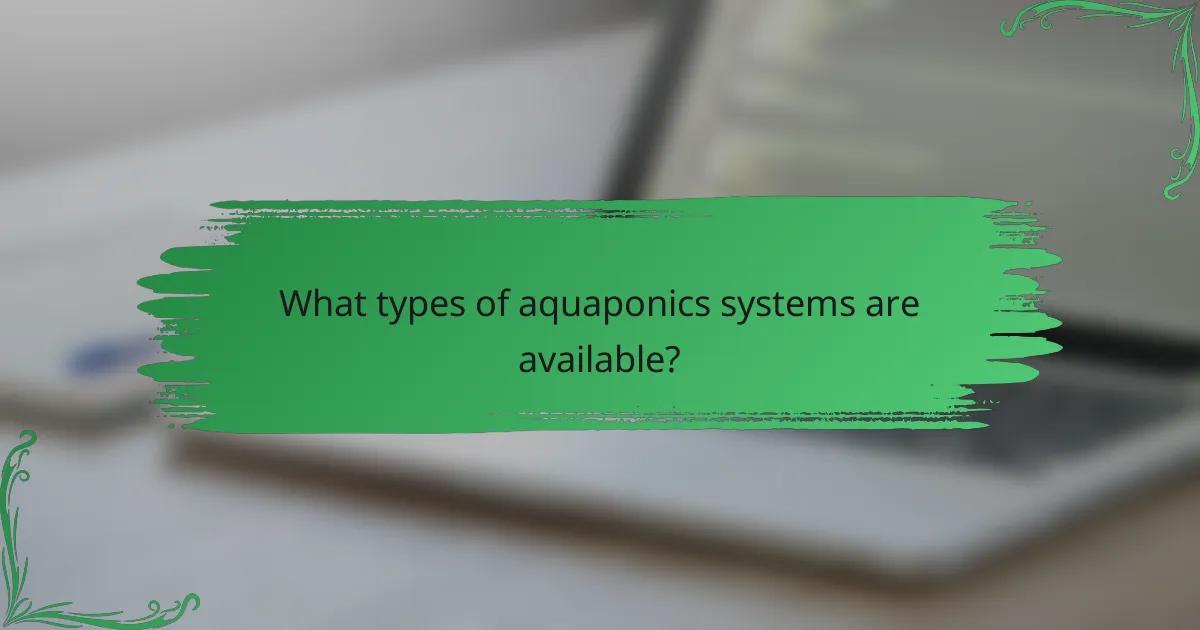
What types of aquaponics systems are available?
Aquaponics systems can be categorized into several types, each with unique features and benefits. The most common systems include media-based, deep water culture, and nutrient film technique systems, each offering different methods for cultivating plants and fish in a symbiotic environment.
Media-based aquaponics systems
Media-based aquaponics systems use a solid growing medium, such as gravel or expanded clay pellets, to support plant roots. This type of system allows beneficial bacteria to thrive, converting fish waste into nutrients for the plants while simultaneously filtering the water.
When setting up a media-based system, ensure the media is clean and free from contaminants. Regularly monitor water quality parameters, such as pH and ammonia levels, to maintain a healthy environment for both fish and plants. This system is often favored for its simplicity and effectiveness in small-scale operations.
Deep water culture systems
Deep water culture (DWC) systems involve suspending plant roots in nutrient-rich water, allowing them to absorb oxygen and nutrients directly. This method is efficient and promotes rapid plant growth, as the roots are submerged in a well-aerated solution.
To implement a DWC system, use air pumps and stones to provide sufficient oxygenation. Be cautious of water temperature, as it should typically remain between 18°C and 22°C to prevent root rot. DWC systems are particularly suitable for leafy greens and herbs, which thrive in these conditions.
Nutrient film technique systems
Nutrient film technique (NFT) systems circulate a thin film of nutrient solution over the roots of plants, which are supported by sloped channels. This method ensures that plants receive a constant supply of nutrients while minimizing water usage.
When designing an NFT system, ensure the channels are properly sloped for effective drainage and nutrient flow. Regularly check the nutrient solution’s concentration and pH to optimize plant growth. NFT systems are ideal for fast-growing crops and can be scaled for both home and commercial use.
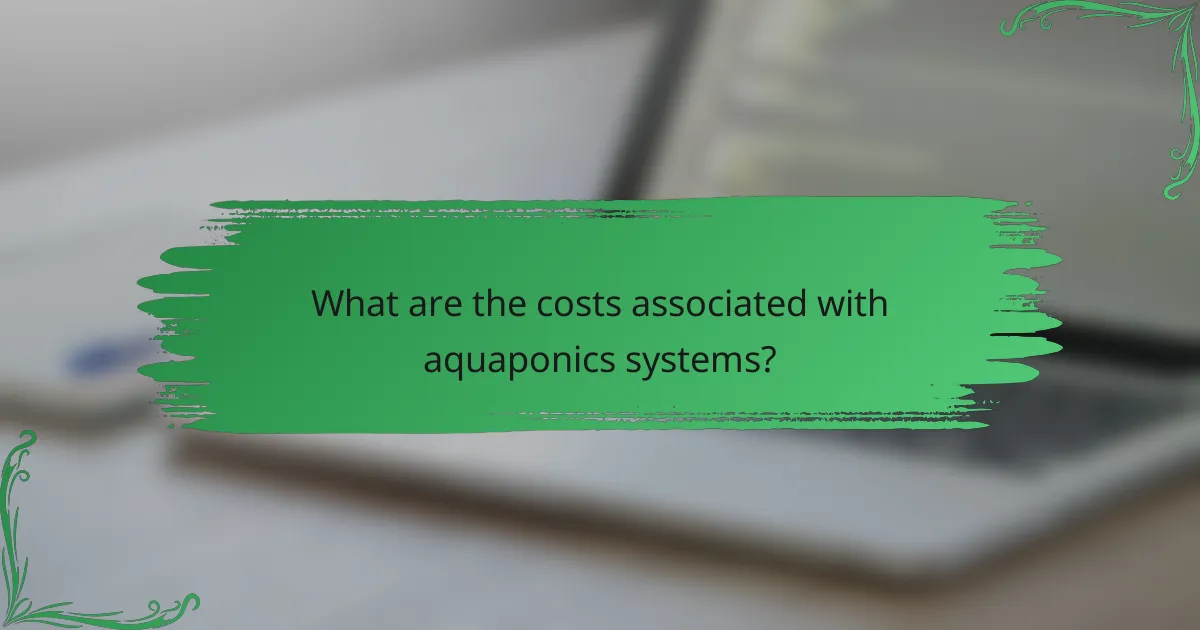
What are the costs associated with aquaponics systems?
The costs associated with aquaponics systems can vary significantly based on the scale and complexity of the setup. Initial investments, ongoing operational expenses, and potential savings on grocery bills all play a crucial role in determining the overall financial picture.
Initial setup costs for home systems
Setting up a home aquaponics system typically involves costs ranging from a few hundred to several thousand dollars. Key expenses include the purchase of fish tanks, grow beds, pumps, and filtration systems. DIY options can reduce costs, but may require more time and effort.
For a basic home system, expect to spend around $500 to $1,500, depending on the size and equipment quality. More advanced systems with automated features can push costs higher, often exceeding $2,000.
Operational costs for commercial systems
Operational costs for commercial aquaponics systems can be substantial, often running into thousands of dollars monthly. Key factors include electricity, water, fish feed, and maintenance supplies. Depending on the scale, these costs can vary widely.
On average, commercial systems may incur operational expenses of $1,000 to $5,000 per month. Efficient management and scaling can help mitigate these costs, but careful budgeting is essential for sustainability.
Potential savings on grocery bills
One of the appealing aspects of aquaponics is the potential savings on grocery bills. By growing your own fish and vegetables, you can significantly reduce food costs, especially for organic produce. Savings can range from 20% to 50% compared to store prices.
For instance, if you typically spend $200 monthly on vegetables and fish, an aquaponics system could lower that expense to $100 or less. This makes aquaponics not only a sustainable choice but also a financially savvy one over time.
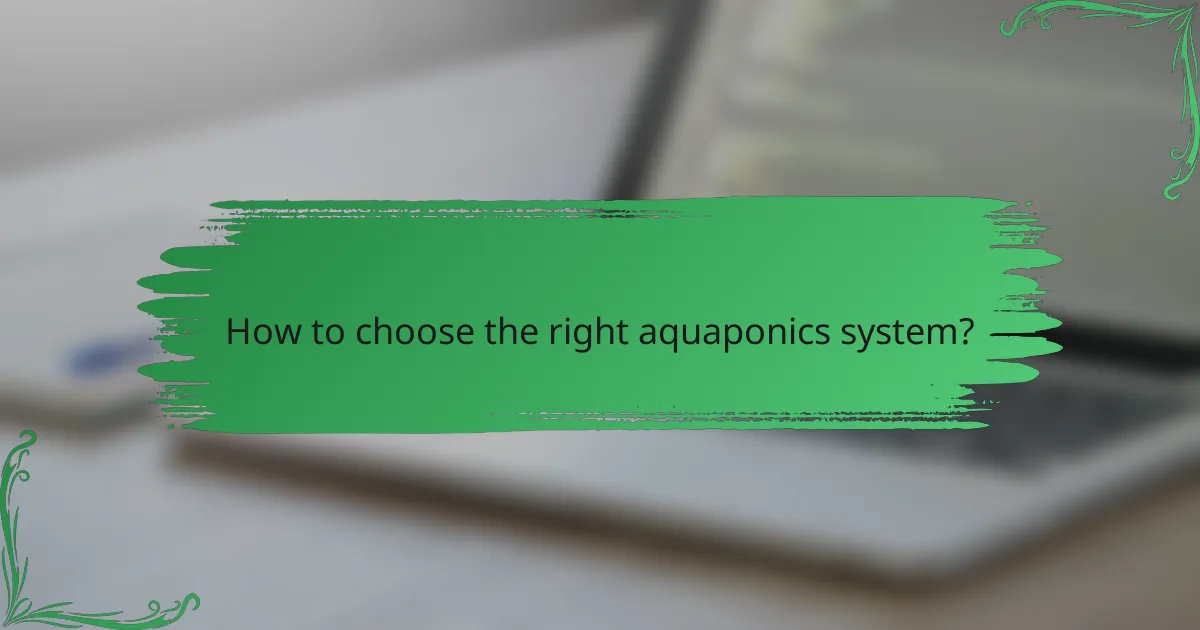
How to choose the right aquaponics system?
Choosing the right aquaponics system involves assessing your available space, the types of plants and fish you want to cultivate, and your overall goals for sustainability and productivity. Understanding these factors will help you select a system that meets your needs and maximizes efficiency.
Consider space and location requirements
Space is a critical factor in selecting an aquaponics system. Systems can vary from small countertop units to large outdoor setups. Ensure you have enough room for the system’s size, as well as for maintenance and access.
Additionally, consider the location’s climate and sunlight exposure. Indoor systems may require supplemental lighting, while outdoor systems should be placed where they receive adequate sunlight without being exposed to harsh weather conditions.
Evaluate plant and fish compatibility
Compatibility between plants and fish is essential for a thriving aquaponics system. Certain fish, like tilapia and catfish, are popular choices due to their hardiness and growth rates. Meanwhile, leafy greens such as lettuce and herbs often thrive in aquaponics environments.
Research the specific needs of both your chosen fish and plants. For instance, some fish prefer warmer water, while others may require cooler temperatures. Matching these needs will enhance growth and minimize stress on both plants and fish.



